
Home | Canal System | Historical Documents | 175th Anniversary
Images | Maps | Tour | Traces | Locks | Boats | Books and Videos | Music | Links



Note: The images noted [CSNYS] below are the property of and used with the permission of The Canal Society of New York State.
Working boats were of various sizes and configurations, although all were limited by the width and length of the standard lock. As the canal was enlarged, the size of canal boats also increased. Below are two illustrations of the different sizes of canal boats used on the Erie Canal at different times, as well as proposals for possible future use.
Most working canal boats on the "Clinton's Ditch" and Enlarged Erie canals included crew quarters, a kitchen, a hold for the goods being shipped, and a stable for the horses or mules. In many cases, the boats were also home for a family, as the father would captain the boat, the mother would be the cook, and the children would play or help out as needed. The boats were towed by teams of horses or mules -- normally there were two teams, one the working team and one housed in the bow of the boat. When off duty, the "Hoggee" or driver would sleep with the off duty team. The normal working shift was six hours on duty, six hours off. Usually, the changeover from one team to the other could be accomplished with little delay, although an animal could occasionally be stubborn, and had to be loaded into the stable using a block and tackle. Here are some pictures of the process of changing teams:

Many different kinds of working boats were used on the canal. Early working boats (or "line boats") carried both people and freight -- the freight usually being lumber, gravel or agricultural products going east, and manufactured products (stoves, nails, cloth, etc.) going west. These boats also helped many families to emigrate to Ohio and other parts of the Midwest by carrying them and their goods, transferring them to lake boats at Buffalo. The number of boats registered each year varied -- the Annual report of the Superintendent of Public Works for the year ended September 30, 1899 listed the number of boats registered and their tonnage from 1844 through 1898.
The following images give some idea of the variety of boats and the products they carried:
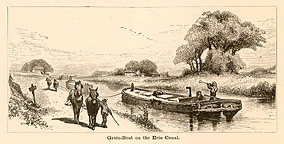 |
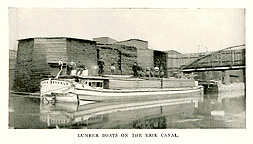 |
 |
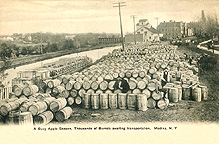 |
| Grain-Boat on the Erie Canal -- from: America Illustrated / edited by J. David Williams. (Boston : DeWolfe, Fisk & Co., c1883) -- p. 88. | Lumber Boats on the Erie Canal -- from: Forest Preservation in the State of New York / by Cuyler Reynolds. In: The New England Magazine (Boston : Warren F. Kellogg), New series, vol. XIX, no. 2, Oct. 1898. | Loading a Coal Barge at Canastota -- date unknown. [CSNYS] | A Busy Apple Season, Thousands of Barrels awaiting transportation, Medina, N.Y. (No. 1943 -- Rochester News Co., Rochester, N.Y.) -- Postcard ; postmarked Jul. 2 & 3, 1906. |
 |
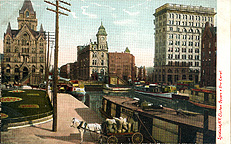 |
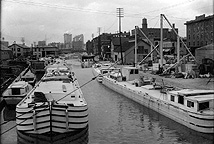 |
 |
| Erie Canal near Schenectady, N.Y. (12448, Robson & Adee, Schenectady, N.Y.) -- postmarked Aug. 9, 1906. Note that two boats are tied together, forming a "double header". | Syracuse, N.Y., Clinton Square & Erie Canal (No. 774 -- The Hugh C. Leighton Co., Portland, ME.) -- Postcard ; UNDB ; not postmarked ; approximately 1906. | Canal boats [in Rochester] / photographer: Albert R. Stone -- photograph : b&w ; 7 x 9 in. -- 1910-1920? (Albert R. Stone Negative Collection, Rochester Museum & Science Center, Rochester, NY). | Fleet in Lock 23, [Brewerton], Aug.18, 1921 [CSNYS] |
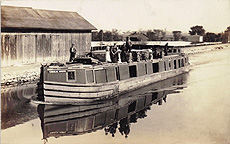 |
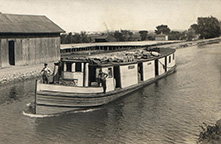 |
 |
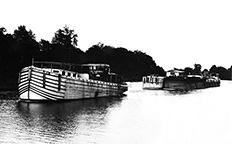 |
| Chas. H. White [Line Boat] -- RPPC ; approximately 1915? | C.M. Warer, Fayetteville, N.Y. [line boat] -- RPPC ; approximately 1915? [CSNYS] | Stern view of canal boat Edith McCourt of Albany, N.Y. -- date unknown. [CSNYS] See also the Bow View. | Canal Steamer and Tow of typical barges, west bound -- date unknown. [CSNYS] |


Breaks in the canal wall were not unusual -- leaks could slowly increase in size until the wall collapsed, and tunnelling muskrats were all too common. When a break occurred, a means of fixing it had to be found quickly. The usual way was to send a "Hurry-Up boat", which had the tools, materials and manpower necessary to fix the break, and fast horses to get to the break as quickly as possible. Below are two images of Hurry-Up boats and their crews:

One of the problems with the old wooden canal boats was their limited life span. After years of (sometimes rough) service, repairs and patching weren't enough to keep them from wearing out. Sometimes, the boat owner would abandon the boat in a stream or feeder, and sometimes park it in the canal equivalent of a wrecking yard. Here are some pictures of a canalboat "graveyard" at the Eastern Widewaters near Rochester:

The old wooden canal boats were eventually replaced with steel boats. In addition to a longer useful life, steel boats had another advantage: the ability to leave the canal and navigate the lakes as well, thus saving on the time and labor of unloading and reloading cargoes. In 1895, the Cleveland Steel Canal Boat Company built and sent out "a fleet of steel canal boats, consisting of one steamer and five consorts, thus establishing a through line of transportation between Cleveland and New York .... The boats are 98 feet over all in length, 17 feet 11 inches wide on top, 17 feet 4 inches wide at the bilge, and have a depth of 10 feet. They are constructed of three-eighths inch open hearth steel ...." (p. 21 and 22). Below are pictures of this fleet:
http://www.eriecanal.org/boats-2.html